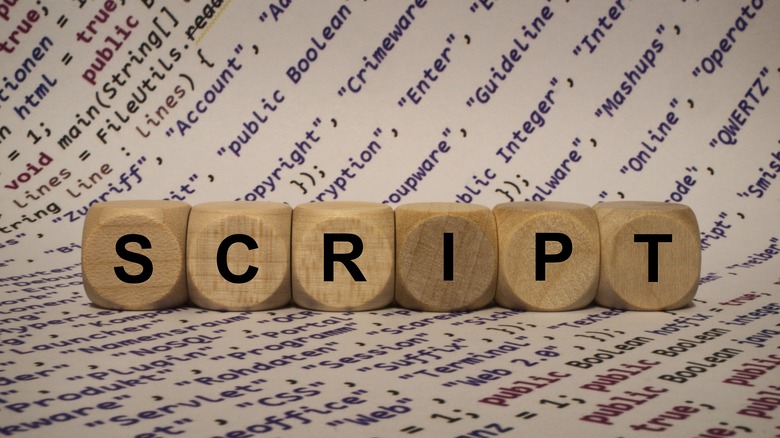What Is Markdown, And Why Should You Use It Instead Of Microsoft Word?
Being able to write well and write quickly is not only an essential job skill, but also an essential life skill these days. Take a moment and think about how much writing you actually do on a daily basis, between:
- reports
- social media messaging
- updating your blog
- making a to-do list or a shopping list
- crafting a receipt for goods or services rendered
Or even jotting down a few notes here and there for that novel you've been planning to get to for the past few years. It adds up quickly, doesn't it?
Writing has become an important, ubiquitous part of our modern-day life, and having essential skills in not only putting words down but also in formatting the written word quickly and efficiently is a vital component of just about every job or venture imaginable. The majority of people use some kind of modern word processing software such as Microsoft Word or Apple Pages in their professional and personal lives.
Frustrations with traditional word processors
Looking back to the dawn of the digital age we're now comfortably living in, the first desktop word processors were designed based on, and largely mirrored, the dominant writing workflow of the time, the typewriter. The final output — the sole embodiment — was physical, and all that mattered was what the document looked like.
One of the main frustrations for people with these applications is that generally speaking, it is a two-step process from conception to final output, in which the actual writing is separated from the formatting. Another frustration is output compatibility. Microsoft Office options like Open XML, Office 97, Rich Text Format, Plain Text Format — these are all different formats that may not always be compatible with other applications.
Many potential formatting errors or incompatibilities are virtually programmed into traditional writing software, and then appear when you output the created document to various formats.
Some formats are more compatible with others, which can become a rather frustrating issue when it comes to cross-platform collaboration. We've all seen that dreaded: "Some changes have been made to the document..." message, after opening an important email attachment from one of your team members, right?
Imagine there was an easier, faster, and more efficient way to write, format, and convert text in the more modern age of blogs, PDFs, HTML output, and messaging platforms. Markdown intends to be that platform.
Is Markdown the solution to an age-old problem?
Unlike the oftentimes cumbersome traditional word processing applications which have numerous buttons for every conceivable function, text written in Markdown can be easily shared between computers, mobile phones, and thus people — independent of platform. No wonder it is quickly becoming quite a game-changer and the new writing standard for academics, scientists, movie script-writers, and many more.
I'm willing to bet my imaginary Pulitzer that the majority of people out there have not heard about this "writer's language" yet, though they've undoubtedly already encountered it.
Ultraedit notes that Facebook chat, Reddit, GitHub, and many other online platforms all let you use different flavors of Markdown to format your messages and comments. If you've ever formatted text in the popular WhatsApp messenger, or in a Slack thread, you've actually used Markdown, as these applications use a minuscule subset of Markdown tags to format the text.
Now that we know where it is used, let's take a deeper look at what Markdown actually is and, more importantly, how to use it in your daily life.
What is Markdown?
Markdown is a lightweight markup language, which is a way to effectively, easily, and quickly create formatted text for digital applications in any of your writing endeavors. It is a "coding" language FROM and especially FOR writers.
Created in 2004 by John Gruber as an easy language for non-coders to write content optimized for the web, Markdown uses a format that can easily be read and converted to HTML.
Its sheer simplicity and minimalist approach to writing and formatting is the main reason why Markdown has grown in popularity over the years, especially amongst writers and publishers. It has found a near cult following among those who swear by it for quick publishing in a fast-paced world. One of its greatest advantages is that you can use any text editor to write in Markdown, making it essentially free to use without the need for installing any special software.
As an example: Are you an **Apple** person *or* an **Android** person?
gets converted to
'Are you an Apple person or an Android person?' upon output.
Compared to traditional word-processors, you are not limited to one piece of software which may not be quite as compatible with others in a collaborative environment. Once written, the Markdown text can then be easily converted to any modern output format or medium imaginable without having to do much extra formatting, whether on a website, PDF, formatted Email, or a website comment.
Why is Markdown better for writers than Word?
Markdown's main advantage over WYSIWYG editors is that you don't have to move your mouse all over the screen to select various formatting options. When you write in an app such as Word, there are a plethora of options in the various toolbars along the top of the screen. Taking your hands off the keyboard to find the right option in these menus takes up precious time that you could spend writing, and can break your focus.
While these apps do have keyboard shortcuts for some functions, they often aren't convenient or intuitive. Markdown discards all of the distractions and lets the writer focus on just the essentials.
Markdown is also easy to learn. Though the syntax is quite extensive and covers the full gamut from bolding text to creating footnotes in an interactive document, the basics of what you'll need to know to start writing quickly and efficiently are easily learned in an afternoon.
Some of the main benefits of Markdown:
- Version control. Those of you who have edited together with others know this problem all too well — sometimes it becomes a real pain to merge all the changes together. This becomes a non-issue due to the fact Markdown works like any other text file merge. Straight, simple, pure, and no drama.
- Edit on any platform. There are no special apps to download. You can simply edit the text with any editor on your phone, tablet, or computer.
- Simplicity is the key. Writing is a bit like meditation — you get into "the zone" where words flow naturally. As such, any interface which takes you out of "the flow" is just another distraction to deal with. Markdown is simple, and thus perfect for anyone who'd much rather concentrate on the words on the screen rather than the mess of buttons along the top, the sides, or the bottom. It's also perfect for those who do not want to remember any of the usual button combinations for formatting.
- File Size. There's something to be said for the file size of a text document being but a fraction of a comparable, fully-formatted Word document in size. (via Hackernoon)
The basics of Markdown Syntax
Markdown's super-simple syntax — say that five times fast — is one of the main reasons why it's a better tool to write on for digital output formats. With simple tools it's possible to do all of your formatting WHILE you're writing.
Here are a few simple fundamentals of the syntax, via markdownguide:
Headers
First of all, the most important piece of 'code' is the number sign (#). With this simple sign, you can create any kind of header.
Simply type "#" followed by a space. So, writing a whole paragraph with a formatted heading only requires one simple (#).
# – Header 1 (largest size for Document heading)
## – Header 2 (2nd largest size for Section heading)
### – Header 3 (3rd largest size for paragraph heading)
Bold Text
Simply add two asterisks (**) in front of and behind the word/phrase.
Example: The problem with kleptomaniacs is that they always take things **literally**.
Becomes: The problem with kleptomaniacs is that they always take things literally.
Italicized Text
In the same manner, adding just one asterisk (*)in front of and behind the text italicizes the text.
Example: The *clickity-clack* of typing was music to his ears.
Becomes: The clickity-clack of typing was music to his ears.
Blockquotes
A simple > (greater than sign) followed by a space will put the proceeding text into a block quote upon output.
Example: > One day I will find the right words, and they will be simple." – Jack Kerouac, The Dharma Bums
Becomes:
One day I will find the right words, and they will be simple
Ordered Lists
It's as simple as 1,2,3. An ordered list can be created just by typing the corresponding number, followed by a period and a space. In a text editor, the numbers have to be manually typed in sequence, but in most Markdown Editors, after hitting the return key, the next sequential number will be automatically created for you on the next line.
1. You can't breathe while your tongue is out.
2. You can't say the letter "P" without separating your lips
3. You just attempted to do it.
4. You are laughing at yourself.
Unordered Lists
An unordered or bulleted list is even simpler to create. There are actually three choices here. All that's required is a quick hyphen, asterisk, or plus sign (-), (*), (+) at the beginning of a line, followed by a space. Once again, in any Markdown or text editor, the next line will be automatically created after hitting the return key.
To do list:
- Hire two private investigators. Get them to follow each other.
- Get into a crowded elevator and say "I bet you're all wondering why I gathered you here today
- Major in philosophy. Ask people WHY they would like fries with that.
Links
Type a left bracket first, then insert the link title and close the bracket, followed by a pair of opening and closing Parentheses in which the actual link is written. Sounds complicated, but it's really just this
Example: [SlashGear](https://www.slashgear.com)
Becomes: SlashGear
Of course, there are many more formatting elements to choose from including tables, task lists, sub- and superscripts, and table of contents.
Nothing is perfect
So far we've looked at only the benefits of this writing language, but are there any drawbacks as well? In short, yes. Nothing is perfect, so there's a bit of criticism as well — albeit, not much from a writer's perspective.
- While being great for simple text, there are some limitations for longer writing tasks (such as creating books, for instance) where one might want to re-use organized text snippets, or have a more complex organizational structure.
- Inserting tables takes a bit of extra effort and there are few options for formatting them.
- Inserting an image manually takes some getting used to. The syntax is not as intuitive in this case.  (via Bit.Ai)
In addition to the cumbersome image syntax, image formatting options are pretty much non-existent. When using a dedicated Markdown editor, inserting an image is a simple drag and drop affair — albeit still without viable formatting options.
Free online Markdown editors
Those previous few criticisms aside, If you are interested in learning all of the ins and outs of this writer's language, Markdowntutorial provides a very good tutorial on all the essential syntax you'll need. The site also dives deeper into shortcuts and hacks that make Markdown easier and faster to use, with plenty of examples to look at. One cool thing to note is that the site, like Markdown, is usable in multiple languages — boosting its productivity for global collaboration.
If you're keen, however, to try it out for yourself through actual writing, there are a couple of great editors available completely free online. Three excellent recommendations here are
- Stack Edit: a free, open-source Markdown editor based on PageDown.
- Dillinger: another text editor that is only useable online, i.e. no downloading of docs.
- HackMD: A great Markdown io for cross-platform collaboration.
Online offerings aren't the only way to write quality Markdown, however.
Recommended standalone Markdown editors
If you do a lot of writing off the web, or would prefer writing via an app that synchronizes across all of your devices, rather than using a free online version without the ability to download, it might be a better choice to use a dedicated Markdown editor instead. Fortunately, there are plenty of these available, as well, depending on your operating system.
On the Mac side, Byword is an exceptional and quite affordable choice. My personal favorite has been iA Writer, for many years now. Another great option is Ulysses.
On the Windows side, Typora is the favorite Markdown editor for many, followed by the aforementioned iA Writer, and last but not least, the free Ghostwriter.
In addition to offering a great writing experience, all of these choices offer small, but important necessities such as:
- word count
- themes (light/dark)
- output preview
- Focus Mode
- Session Statistics, and more
Conclusion
Now that we know what Markdown is and have delved into the basic syntax a bit, is it the end-all, be-all writing tool for every occasion? Of course not! Use the right tool for the job at hand, as the old saying goes. No one is saying that Word, Google Docs, Pages, and others aren't useful anymore. None of these programs are inherently impractical per se, and there are plenty of reasons why you'd want to use one of them over Markdown in certain situations. They each have their pluses and minuses dependent on usage situation.
If you simply want or need to write and put words on a page, however, and/or get lost in the writing process — aka being "in the zone" — I'd strongly suggest Markdown as the way to go. It allows writers to focus on the actual content once the basic syntax becomes second nature, as it's much faster than writing and then formatting your document manually. Along with thousands of writers and scientists, you'll wonder how you ever managed to live without it once you've been down that path.
So the final question here would be:
Would Shakespeare have useth Word or Markdown?
The answer seems quite clear. Wouldst he be alive today, the master of eloquent, epigrammatic grandiloquence would have surely preferred the simple, elegant sophistication of Markdown to the rather complex, turgid inflexibility of traditional word processors for his prose.









